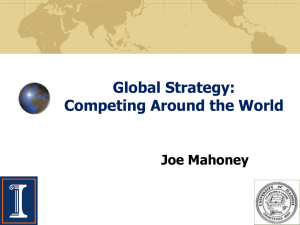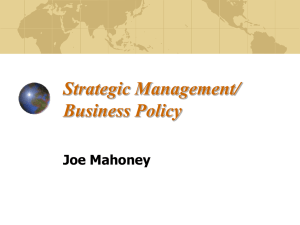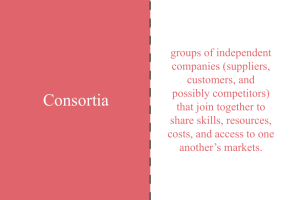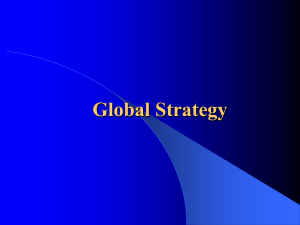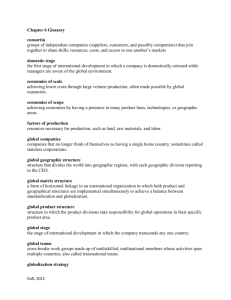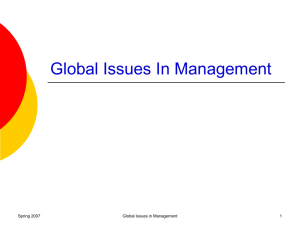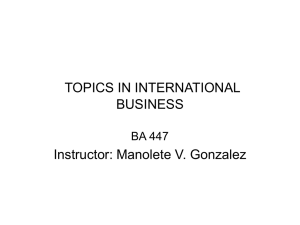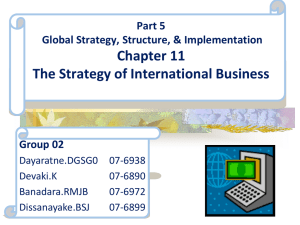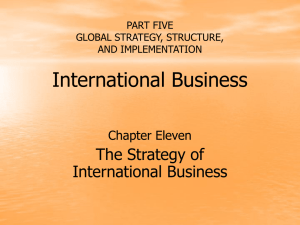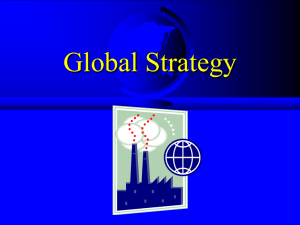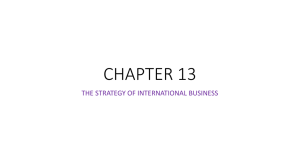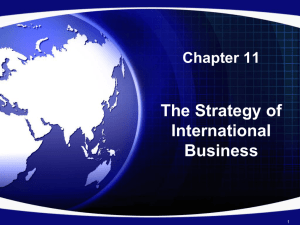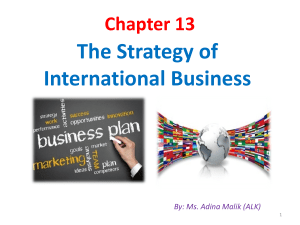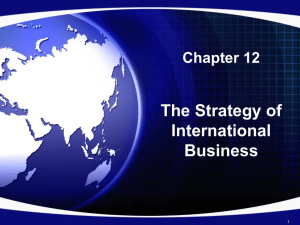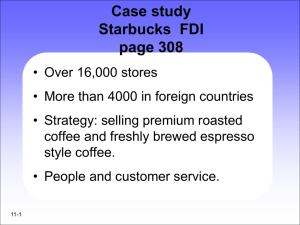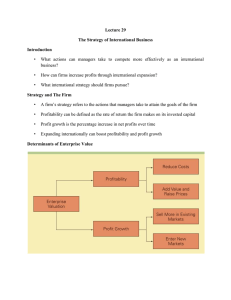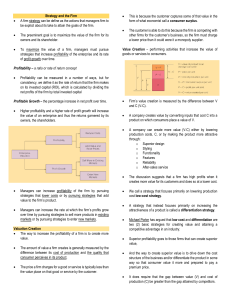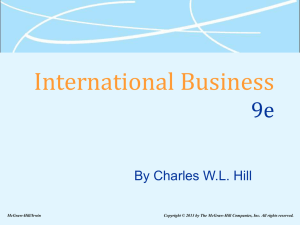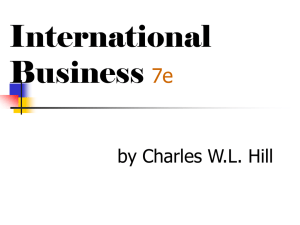International Strategy
advertisement
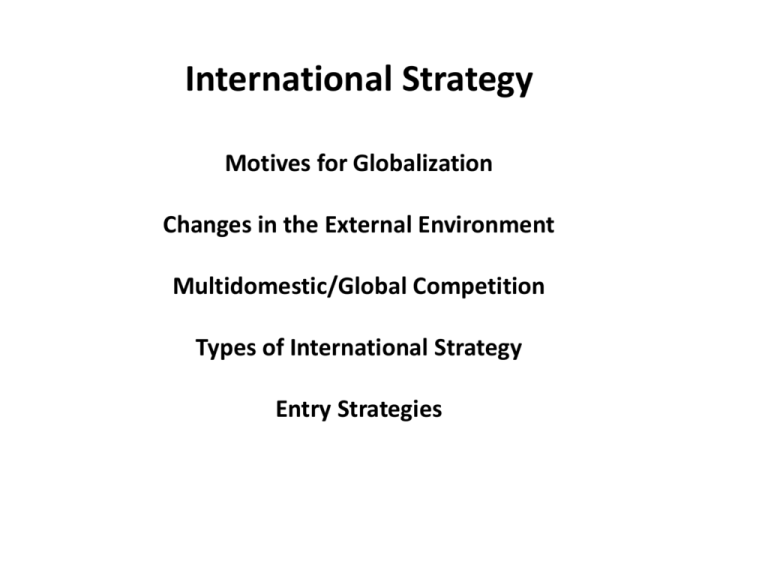
International Strategy Motives for Globalization Changes in the External Environment Multidomestic/Global Competition Types of International Strategy Entry Strategies Globalization The shift toward a more integrated and interdependent world economy. (Hill, 2006) Globalization of Production The sourcing of goods and services from locations around the globe to take advantage of national differences in the cost and quality of factors of production (Hill, 2006). Human Resources Capital Capital (Technology) (Facilities) Entrepreneur Natural Resources Globalization of Markets Moving away from an economic system in which national markets are distinct entities, isolated by trade barriers and barriers of distance, time, and culture (Hill, 2006). Consumer Products Starbucks Citicorp McDonalds Industrial Products Oil Wheat Commercial Aircraft Why might there be opposition to globalization? Why do firms globalize their operations? Who here has been involved in International Operations? Who has traveled internationally? Who is from another country? What happens to the firm’s external environment as they move overseas? MACRO INDUSTRY OPERATING Economic Factors: Monetary and Fiscal policies, ,exchange rates, economic development, type of economic system. Etc. Technological Factors: Regulations on technology transfer, information flow, infrastructure, patent and trademark protection, etc. Political/Legal Factors: Form of government, tariffs, protectionist sentiment, terrorist activity, legal system, government’s attitude toward foreign firms, employment laws, etc. Social/Cultural Factors: beliefs, values, attitudes, opinions, lifestyles, human rights, literacy levels, language, social institutions, skill level of the workforce, etc. Balancing Macro Factors is Key Do low wages in developing countries translate into lower manufacturing costs? Globalization in Competition Multi-domestic Competition Global Competition Multidomestic Competition Competition is essentially segmented from country to country. Competition in one country is independent of competition in other countries. Think in terms of the competitive forces (Porter’s 5 Forces) Examples: Grocery, healthcare ****In a multidomestic industry, a global corporation’s subsidiaries should be managed as distinct entities. Global Competition Global competition occurs when competition crosses national borders. A firm’s strategic moves in one country can be significantly affected by it’s competitive position in another country. Once again think about the competitive forces. Examples: Automobiles, Consumer electronics, Petroleum How do firms position themselves to compete in the global marketplace? Competing Pressures Pressure for Local Responsiveness Pressure for Cost Reductions Consumer’s Tastes and Preferences Commodity-type product Differences in Infrastructure or Traditional Practices Differences in Distribution Channels Demands of Host Governments Universal needs of customers Competitors use a low cost position Multidomestic Strategy Focus: Local Responsiveness Customize the strategy to fit the circumstances of each host country Little to no coordination of strategy across countries Form subsidiary companies to handle operations in each host country; each subsidiary operates more or less autonomously Impact on value chain? Global Strategy Focus: Cost Reduction Same basic strategy worldwide (minor variations where essential) (e.g., Intel) Takes advantage of location economies Locate subunits near high-quality raw material Locate subunits near sources of high-quality or low cost labor Seek low cost financing anywhere in the world Much more worldwide coordination All major strategic decisions are closely coordinated at global headquarters. Structure is designed to unify subsidiaries. Impact on value chain? High Global Strategy Transnational Strategy Pressures for Cost Reduction International Strategy Multidomestic Strategy Low Low Pressures for Local Responsiveness High International Strategy Low Pressures for Local Responsiveness and Cost Reduction Skills and products are transferred to foreign markets were local competitors lack those skills Parts of the value chain remain in the home country (e.g., R&D) Parts of the value chain are duplicated throughout the world (e.g., manufacturing) Works best when: industry cost pressures are low and local capabilities are underdeveloped or non existent. Boeing: Production and marketing (local), sales force (global) Televisa (Mexico’s largest media firm): Spanish soap operas Transnational Strategies High pressures for both local responsiveness and cost reduction A type “Best cost” strategy wherein companies try to simultaneously achieve advantages from low cost and differentiation. Competencies are developed world-wide and transferred as appropriate Experience Curve Effects Location Economies Local Responsiveness Entry Strategies Licensing Exporting Franchising Contract Manufacturing JV and Strategic Alliances Least Foreign Direct Investment Most Amount of Commitment, Control, Risk and Profit Potential Strategic Alliance A B Joint Venture A B C Can be leveraged internationally by linking value chain activities Motivations for Partnerships 1. Generate scale economies: Toyota/GM joint venture (Toyota could spread fixed investment over more units) 2. Gain access to strategic markets: Japanese firm, JVC, provided design technology to partner in exchange for access to European market. 3. Overcoming trade barriers: Inland Steel and Nippon Steel built cold steel plant in Indiana (Nippon supplied technology, capital and access to Japanese firms in the US). 4. Use excess capacity: Toyota/GM joint venture used an idle GM plant 5. Gain access to low-cost manufacturing capabilities: GE sourcing microwaves from Korea.
